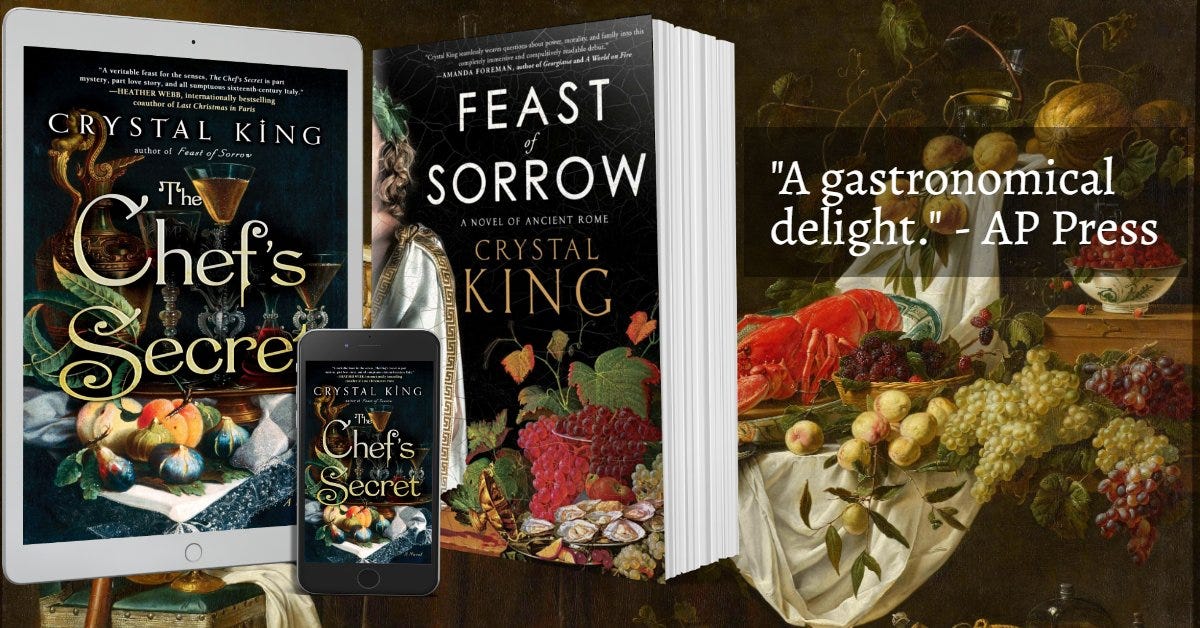
A year ago, I decided, rather ambitiously, that I would take on the mantle of blogging once a week. Over two thousand of you decided to come on that journey with me. I’m so grateful for you letting me into your inbox with my ramblings. I’ll be carrying on with this weekly post thing in the new year after a two-week break. 2024 is going to be a good one—I can feel it!
The Surprising Ancient Roman Origins of Many Christmas Traditions
The symbols are familiar to us—the wreaths, fir trees, mistletoe, light in the darkness of winter, mistletoe and ivy, caroling, the giving of gifts and a big feast with family and friends.
Interestingly enough, these same traditions would also be equally familiar to the pre-Christian denizens of ancient Rome. An ancient holiday, Saturnalia, was the origin to many of the rituals that we observe today during the Christmas season.
Saturnalia was a feast held in honor of Saturn, the Roman god of agriculture, liberation, and time. Saturn was considered an important deity in Roman religion and myth. As the god of the sowing of seed, he was associated with wealth, abundance, and the Golden Age when humans enjoyed the gifts of the earth without labor. The Saturnalia festival was first introduced around 217 BC and quickly became one of the most popular Roman festivals. It grew to be the most popular holiday of the Roman year, spreading across the Empire wherever the Roman legions went. Saturnalia lasted for a full week, an exhilarating period of feasting, gambling, drinking, and revelry. It was a time when slaves could go without punishment and men celebrated free speech. The holiday was marked by much merrymaking and license. It was a time free of work, courts were not in session, schools were closed, exercise went by the wayside and no wars could be declared. The normal Roman social order was turned upside down - masters served slaves at banquets instead of the other way around. However, there were limits to the role reversals. True equality was not sought and slaves still had to prepare the festive meals and provide entertainment.
It was also a time when ancient rituals and symbols came into play—many of the same that form the basis for our holiday traditions today.
December 25th
December 25th is not the real birthday of Jesus. His birth is not mentioned in the Bible at all or in any sacred writings. The more likely reason for this choice of date is to coincide with pagan mid-winter festivals in order to unify pagan and Christian worship celebrations. The 25th was the birthday of Saturn and it also happened to coincide with a date important in the cult of Mithras, an ancient Roman mystery religion that shared many similarities with Christianity. Many pagans had come to worship Mithras, the Persian god of light, whose birthday was celebrated just after the winter solstice. Christian leaders perhaps chose the 25th to encourage the new converts to celebrate Christ's birth rather than continue their pagan festivals.

Christmas Wreaths
The ancient Romans and Greeks both believed that wearing a wreath as a crown, or corona, would help the wearer stave off drunkenness. They were made from flowers and tree branches and during Saturnalia were often made from fir (in honor of Saturn’s grandson, Faunus, known in Greek as Pan) and ivy (in honor of Saturn’s consort, Ops). Roman soldiers gave Jesus a crown of thorns (it may have been holly) in mockery of his Roman “triumph.”
The Romans would also use fir branches as decor inside and outside buildings, to celebrate fertility, abundance and life in the depths of winter.
Holly and Ivy
Like the branches of the fir tree, holly and ivy are plants that stay green throughout the year. Holly was a plant sacred to Saturn and the ancient Romans used it liberally as a decoration during the Saturnalia festivities. Ivy was sacred to Bacchus, the god of wine and revelry, and was used all over Rome in celebration of Saturnalia. It was also a symbol of marriage and friendship and Saturnalia was a time for family and friends to come together.
Mistletoe
Ancient Greeks first began the tradition of kissing under the mistletoe. The Romans adopted it as part of the Saturnalia feast and would sometimes settle wartime agreements underneath a mistletoe sprig, making it a symbol of peace. As an evergreen plant, it was also used as a symbol of abundance and fertility in Saturnalia decorations.
Caroling
During Saturnalia people would go singing door to door, but fortunately for us, caroling of today does not entirely mimic another Saturnalia tradition—running through the streets naked and singing. The latter is the reason that throughout the centuries Christian churches have wavered on their policies about caroling, with the idea that singing coincides with debauchery.

Gift Giving
The concept of giving gifts was an important part of Saturnalia. Usually, the gifts were small trinkets, dolls, sweets, and the like. Masters would also give gifts to their slaves (perhaps a precursor to the idea behind Boxing Day, when employers would give a gift to their servants the day after Christmas).
Taking Care of the Less Fortunate
Saturnalia was also a time of swapping places. Masters would trade places with their slaves, serving them at meals instead of the other way around (although the slaves would still have to cook the meals). This tradition of masters serving servants would continue for a time but eventually fell out of favor. Today we look for ways to help those who are needier than ourselves, with many working in soup kitchens on the holiday to feed the poor. In the UK, British officers traditionally serve the holiday meal to junior officers, with Prince Harry carrying on the practice in past years.
Christmas Lights
The winter solstice was the longest day out of the year, and light was an important part of the holiday ritual. Romans gave gifts of candles to each other and placed them in the windows of their homes to call the sun back from the darkness.
Feasting
Saturnalia marked the very end of the harvest. Ancient Romans would dine on the fruits of their labors, with all manner of foods, apples, nuts, honey, fritters, meat, and heavily spiced wine. Emperors would shower figs and sweets on crowds during gladiator games. On December 25th, the birthday of Saturn, they would dine on wild boar or the flesh of a goose or an exotic bird such as a peacock. Today, we still eat ham and goose in abundance during the Christmas holidays.
As Christianity grew within the Roman Empire, Saturnalia gradually transformed, blending its traditions with Christian rituals. This melding formed the foundation of many modern Christmas practices, illustrating the adaptability and enduring nature of these ancient customs.
While history tells us that many of our Christmas traditions were appropriated from pagan rituals (not just Roman, but many other traditions ranging from the Vikings to Germany and even Mexico, where poinsettias originate), the devout should take heart in the underlying meanings of these customs. They symbolize the importance of family, convivium, good overcoming evil, and light breaking apart the darkness and life growing once again. All perfectly good reasons to celebrate, most would agree.
A variation of this article first appeared in Frolic.
WHAT’S BRINGING ME JOY THIS WEEK
David Bowie in Christmas Tree fashion, 1975
Are you on Threads yet? If not, you are late to the party. And now that it’s open to the EU, I’m seeing a huge influx of new users (there were already 140M people on the platform before that). The bookthreads community there is especially vibrant. I’m @Crystallyn14.
Click through for a video of the most adorable holiday food art.
This lovely version of a holiday favorite by Billie Eilish.
Another video to click through to…Italy comes alive with the holiday season. Belissima! Buon Natale a tutto!
I am wishing you and yours a happy holiday season and a fantastic start to your new year! See you in 2024!
If you love food and love Italy, and haven’t read THE CHEF’S SECRET or FEAST OF SORROW, click the links to learn where to buy your copy! 🍒🍗🍷
You can also follow me in these places too: Website | Instagram | Facebook | Threads








